[1]
M.A Sainz, P.Pena, S.Serena, A. Caballero. Influence of design on bioactivity of novel CaSiO3- CaMg(SiO3)2 bioceramics: in vitro simulated body fluid test and thermodynamic simulation, Acta Biomater 6 (2010) 2797-2807.
DOI: 10.1016/j.actbio.2010.01.003
Google Scholar
[2]
Herlian syah, M.K Suyito, Dewo, P. Abdul Shukor, M.H.B. Ide Ektessabi, Ari. Development and characterization of bovine hydroxyapatite porous bone graft for biomedical application, Adv. Mater. Res. 277 (2011) 59-65.
DOI: 10.4028/www.scientific.net/amr.277.59
Google Scholar
[3]
Xiang-Hui Huang, Jiang Chang. Synthesis of nanocrystalline Wollastonite powders by citrate-Nitrate gel combustion method, Mater. Chem. Phys. 115 (2009)1-4.
DOI: 10.1016/j.matchemphys.2008.11.066
Google Scholar
[4]
Jie Wei, Fangping Chen, Jung Woog Shin, Hua Hong, Chenlong Dai, Jiancan Su, Changsheng Liu. Preparation and characterization of bioactive mesoporous wollatonite- polycaprolactone Composite scaffold, Biomater 30 (2009) 1080-1088.
DOI: 10.1016/j.biomaterials.2008.10.046
Google Scholar
[5]
A. Binnaz Yoruc¸ Hazar. Preparation and in vitro bioactivity of CaSiO3 powders. Ceram. Int 33 (2007) 687–692.
DOI: 10.1016/j.ceramint.2006.12.013
Google Scholar
[6]
Kaili Lin, Jiang Chang, Jianxi Lu. Synthesis of wollastonite nanowires via hydrothermal microemulsion methods. Mater. Lett. 60 (2006) 3007–3010.
DOI: 10.1016/j.matlet.2006.02.034
Google Scholar
[7]
R.P. Sreekanth Chakradhar, B.M. Nagabhushana, G.T. Chandrappa , K.P. Ramesh, J.L. Rao. Solution combustion derived nanocrystalline macroporous wollastonite ceramics. Mater. Chem. Phys. 95 (2006) 169–175.
DOI: 10.1016/j.matchemphys.2005.06.002
Google Scholar
[8]
Jie Wei, Fangping Chen, Jung Woog Shin, Hua Hong, Chenlong Dai, Jiancan Su, Changsheng Liu. Preparation and characterization of bioactive mesoporous wollatonite- polycaprolactone Composite scaffold, Biomater 30 (2009) 1080-1088.
DOI: 10.1016/j.biomaterials.2008.10.046
Google Scholar
[9]
J.M. Raquez, D.T.J. Barone, Z. Luklinska,O. Persenaire, A. Belayew, J. Eyckmans, J. Schrooten, and Ph. Dubois. Oesteoconductive and bioresorbable composites based on poly-(l,l-lactide) and pseudowollastonite: from synthesis an interfacial compatibilization to in vitro bioactivity and in vivo osseointegration studies, Biomacromolecules 12 (2011) 692-700.
DOI: 10.1021/bm101327r
Google Scholar


